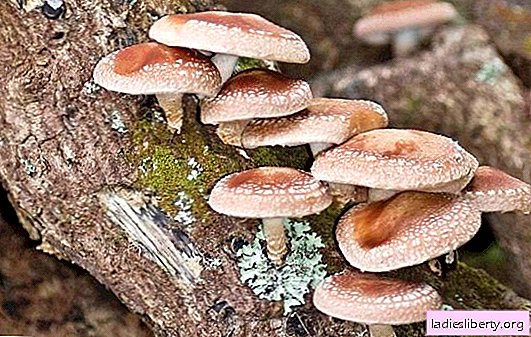
Japanese forest mushrooms, also known as shiitake, differ not only in excellent taste, but also in many useful qualities, thanks to which it is possible to significantly improve health, rejuvenate and lose weight. Therefore, it is important to know as much as possible about them.
What can be said about the benefits of shiitake and the rules for their use in general
Today, shiitake (the second and more official name - edible lentil) is among the five most popular in terms of market demand and the volume of mushroom cultivation in the world.
And over two millennia, they are known as one of the main ingredients in the cuisines of Japan, Korea, China and some regions of Southeast Asia, where, by the way, they grow in the wild.
Shiitake is a tree mushroom that grows especially densely on felled trunks.
But the volumes of its harvest collected in the forests are insignificant in comparison with what is cultivated artificially. And the value of mushrooms depends on cultivation methods:
· Shiitake grown on natural solid wood and in natural light, that is, in conditions as close to natural as possible, are distinguished by the richest composition and useful properties (as well as gourmets assure of taste).
· The second in variety (and properties significant for the human body) are shiitake collected on plantations in enclosed spaces where they grow on sawdust. And in this case, it can not do without artificial nutritional supplements and even, sometimes, pesticides.
Naturally, the fungus cultivated in the first way is several times more expensive. But worth it.
In oriental medicine, it has always been considered the main, along with ginseng, an element of life-prolonging recipes, and is also recommended as a general restorative, restoring strength after high physical exertion and serious illnesses.
Shiitake can be called the "king" in fungotherapy (the treatment of various ailments with the help of mushrooms and drugs from them).
Outwardly, shiitake resemble champignons, but their convex hat (with a diameter of 3 to 18 cm) usually has a brighter color in various shades of coffee brown. Sometimes cracks cover a slightly velvety hat - this is normal, but what is undesirable to find out is the dark spots on the bottom of the mushroom - this usually indicates that it is old.
Tastier and more nutritious, of course, young mushrooms, they are more tender. But larger shiitake wins in terms of richness of taste.
They are eaten fresh (and sold also frozen), dried and less often pickled.
The pulp is white and creamy, dense and fleshy, with a pronounced taste and slightly pungent, with a characteristic forest aroma reminiscent of porcini mushrooms.
Hats are the main value, while the legs are stiff and of course you can cook them too, but for many dishes you can neglect them.
As for the serving options, there is only one rule - Shiitake is not eaten raw, only after heat treatment, and you can cook them according to almost any recipe in which mushrooms are only present.
The energy value of shiitake is about 34 kcal per 100 g.
Also for this weight in mushrooms contains:
2.1 g of protein;
6.8 g of carbohydrates;
· 0 g of fat.
Shiitake mushroom protein is perfectly absorbed and all 18 amino acids serve as a source of "building material" for the cells of the human body, its muscles, as well as maintaining metabolic processes in the body.
Complex carbohydrates (polysaccharides) give Shiitake a unique property to maintain and stimulate the human immune system, through the fact that these substances contribute to the production of interferon, which resists the proliferation of cellular protein viruses. And thus, it is useful to include Japanese wild mushroom on the menu during the season of colds (and flu epidemics).
The Shiitak fully presents B vitamins, as well as D and C, from the mineral assortment it is worth noting potassium, copper, manganese, selenium, calcium and iron.
It is noteworthy that these fungi improve the digestibility from other foods of those micro and macro elements that are present in them.
Shiitake prevent heart disease and, by reducing the level of "bad" cholesterol (due to the amino acid erythadenine), they prevent the development of vascular diseases.
How is the benefit of shiitake
The complex of biologically active substances in shiitake, as well as the high content of dietary fiber, provided that mushrooms are regularly consumed, contribute to:
· Establishing metabolism;
· Timely and complete removal of toxins, slags and radionuclides from the body;
· Improving digestion and healing of damage to the gastric mucosa (which makes these mushrooms extremely useful for gastritis and ulcers).
Due to the ability to activate insulin production, Japanese wild mushroom can be recommended to be included in the menu for diabetes.
Also, the positive effect of shiitake on the human body is expressed in the following:
· Improving the functioning of the nervous system;
· Improvement of the liver (in particular, mushrooms contribute to the rapid restoration of organ functionality after hepatitis);
· Relief of pain with joint diseases;
Lowering blood pressure;
A decrease in coagulability of too thick blood (which is an effective prevention of thrombosis);
· Increase physical stamina.
What are the benefits of shiitake for women
Like all mushrooms, shiitake contain a minimum of calories and they can and should be safely included in dietary nutrition to correct the shape and maintain shape, to improve your beauty.
One of the most useful substances in the composition of shiitake in this regard can be considered:
Coenzyme Q10 - a rejuvenating organism at the cellular level;
· Antioxidant L-ergotionine - inhibiting the activity of free radicals that destroys cells (which can lead, in addition to premature aging, to cancer).
And the latter in shiitake contains more than in wheat germ and chicken liver.
Many elements of the chemical composition of shiitake contribute to the health and perfection of the skin (treatment of dermatitis and acne), moreover, it is not only about treating yourself to mushrooms.
Special mention deserves the specificity of the use of the fungus in cosmetology.
Elite cosmetics companies have long paid attention to them and include shiitake extract in lotions and creams.
In particular, thanks to kojic acid, it becomes possible to lighten (stopping the excessive production of melanin) and rejuvenate the skin, give it elasticity, smooth out fine wrinkles.
Similar effects, as well as reducing the oily skin and giving it a smooth matte tone, can be achieved by adding crushed mushrooms (or their extract) to home or professional products (masks).
Which Shiitake May Harm
So far, there have not been enough (for specific conclusions) studies about the dangers of Shiitake when combined with drugs, but still, when taking serious drugs, it is recommended to use them simply at the call of appetite (that is, a little), and not get carried away with them systematically and copious with healing purposes.
But taking into account what is already known to scientists, it is worth giving up shiitake for the time of taking funds that reduce blood coagulation.
Shiitake in general, in principle, should not overeat (although this is not easy to achieve) - it may not cause serious troubles (it all depends on the individual sensitivity of the body), but it can certainly cause upsets in the stomach and intestines.
Also, many doctors insist that in order to avoid harm from shiitake, they should be excluded from the diet for bronchial asthma, during pregnancy and during breastfeeding.











